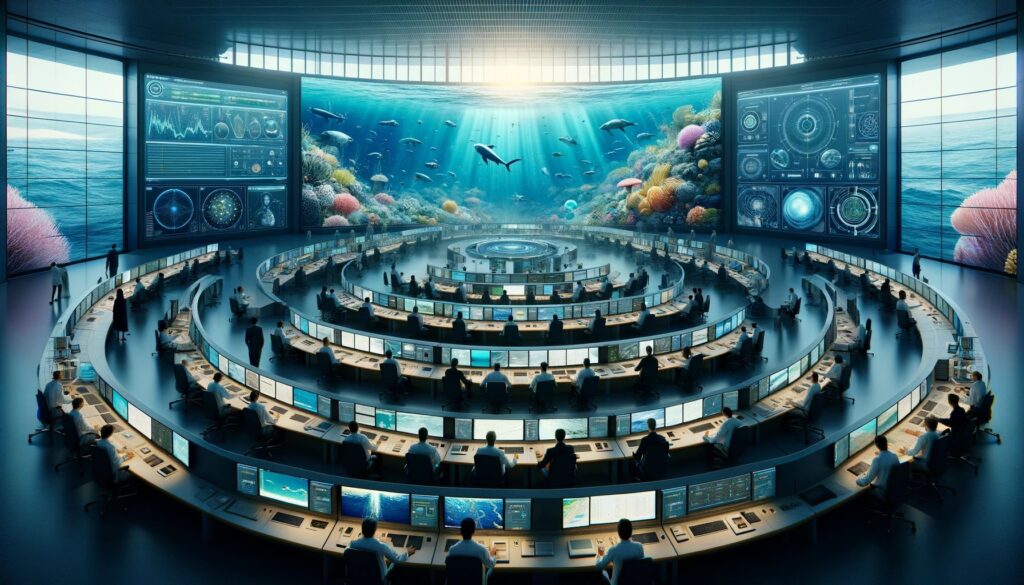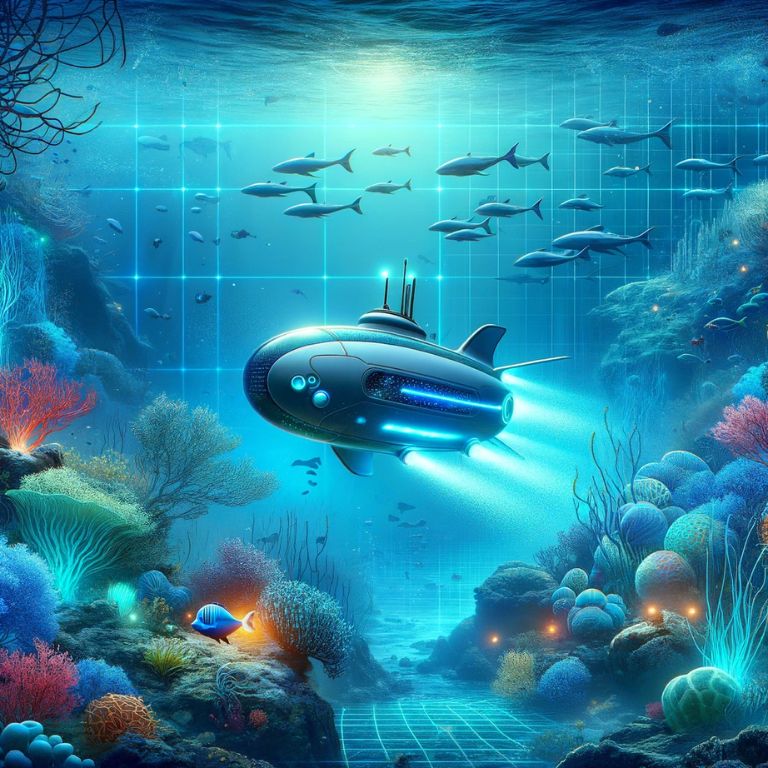In recent years, generative artificial intelligence (AI) has emerged as a groundbreaking force, particularly in the realm of ocean exploration. This advanced form of AI is not just about processing or analyzing data; it’s about creating new data and models that can mimic real-world phenomena. In the context of ocean exploration, generative AI stands as a pivotal tool, offering new ways to navigate, understand, and predict the mysteries of the ocean.
Generative AI refers to a subset of artificial intelligence technologies that can generate new content, from images and videos to simulations and predictive models. These technologies leverage complex algorithms, often based on neural networks, to analyze existing datasets and produce new, synthetic outputs that retain the characteristics of the original data. This capability is particularly useful in fields like oceanography, where the environment is vast, dynamic, and largely unexplored.
Application in Ocean Exploration
The application of generative AI in ocean exploration is multifaceted. By analyzing vast datasets, including satellite imagery and sensor data from underwater vehicles and buoys, these AI systems can create detailed predictive models for ocean behavior, map previously uncharted underwater terrains, and simulate complex oceanographic processes.
Analyzing Satellite Imagery and Sensor Data
Satellites and sensors collect immense amounts of data from the world’s oceans every day. This data includes variables like sea surface temperature, salinity levels, ocean currents, and even biological factors like chlorophyll concentrations. Generative AI can process and analyze this data more efficiently than traditional methods, identifying patterns and correlations that might be invisible to the human eye.
| Purpose | To forecast various ocean behaviors, including weather patterns, climate change impacts, and marine species migration paths. |
| Function | Utilizes generative AI to simulate diverse scenarios, aiding scientists in gaining deeper insights and more accurate predictions regarding oceanic behavior. |
| Benefits | – Enhanced understanding of ocean phenomena. – Improved forecasting of weather patterns and climate change effects. – Better tracking and prediction of marine species’ movements, aiding conservation efforts. |
Mapping Underwater Terrains
The ocean floor remains one of the least explored areas on our planet. Traditional mapping techniques are time-consuming and often limited in scope. Generative AI, through its ability to process large datasets from sonar and radar readings, can assist in creating detailed maps of underwater terrains. This has significant implications for geological and biological research, as well as for navigation and exploration.
Navigating the Vast Blue: AI in Oceanic Data Analysis
How AI Analyzes Satellite Imagery and Sensor Data
The use of AI in analyzing satellite imagery and sensor data is transforming the way we understand the oceans. Advanced algorithms and machine learning techniques enable AI to process and interpret vast amounts of data far more quickly and accurately than traditional methods. This includes everything from high-resolution satellite images capturing the surface of the seas to the intricate data collected by sensors on buoys, ships, and underwater drones. By identifying patterns, anomalies, and trends in this data, AI provides a comprehensive view of oceanic conditions, offering insights into aspects like sea surface temperatures, wave patterns, and even the presence of certain chemical compounds or pollutants.
Application in Studying Marine Environments
The application of AI in studying marine environments extends beyond mere data analysis. It plays a crucial role in ecological research, aiding in the monitoring of marine biodiversity and the health of various ecosystems. For instance, AI algorithms can analyze images and sensor data to track the population and movement of marine species, providing crucial information for conservation efforts. Additionally, AI-driven analysis of ocean data helps in understanding the impacts of climate change on marine environments, offering predictive insights that are vital for formulating effective environmental policies and strategies. The ability of AI to process and interpret complex environmental data not only deepens our understanding of the oceans but also empowers decision-makers to act more effectively in the face of environmental challenges.
Predicting the Unpredictable: AI in Ocean Behavior Forecasting

Creating Predictive Models for Ocean Behavior
The creation of predictive models for ocean behavior is a critical application of AI in oceanography. These models leverage vast datasets to forecast a range of oceanic phenomena, from currents and tides to long-term changes due to climate shifts. By applying machine learning algorithms, AI systems can identify patterns and trends that are not immediately obvious, allowing for more accurate predictions of ocean conditions. These models are vital for everything from navigation and shipping to fishing and coastal management, helping to predict ocean conditions days, weeks, or even months in advance.
Impact on Anticipating Natural Disasters
AI’s ability to forecast ocean behavior has a profound impact on anticipating and responding to natural disasters:
- Tsunami Warning Systems: AI models can analyze seismic data and oceanic changes to provide early warnings of tsunamis, allowing for timely evacuations and preparations.
- Hurricane and Storm Tracking: AI-driven models predict hurricane paths and intensity, aiding in disaster preparedness and minimizing potential damage.
- Flood Forecasting: By analyzing rainfall data and river flows, AI can predict flooding events, especially in coastal areas prone to storm surges.
- Erosion and Coastal Change Prediction: AI helps in predicting coastal erosion patterns, aiding in the planning of coastal defenses and infrastructure.
Mapping the Unseen: AI in Underwater Terrain Mapping
Techniques Used for Mapping Underwater Terrains
The mapping of underwater terrains using AI involves a variety of sophisticated techniques:
- Sonar Data Processing: AI algorithms process data from sonar equipment, used extensively in mapping the seafloor, to create detailed topographical maps.
- Satellite Imagery Analysis: AI interprets satellite imagery to identify underwater features in shallower waters where light penetration allows for optical imaging.
- 3D Modeling: Advanced AI models convert data from sonar and radar into three-dimensional representations of underwater landscapes.
- Autonomous Underwater Vehicles (AUVs): AI guides AUVs in collecting high-resolution data from deep-sea environments, often inaccessible to humans.
Importance in Geological and Biological Research
The AI-driven mapping of underwater terrains holds immense importance in both geological and biological research. Geologically, it enables the detailed study of seabed formations, tectonic plate boundaries, and underwater volcanoes, contributing to our understanding of Earth’s geologic history and processes. From a biological perspective, mapping provides insights into diverse habitats and ecosystems, aiding in the discovery of new marine species and the study of biodiversity patterns. This level of understanding is crucial for conservation efforts and in assessing the health of marine ecosystems in the face of environmental changes and human impacts. Moreover, accurately mapped terrains are invaluable in exploring underwater resources and in planning for sustainable oceanic development.
Simulating the Seas: AI in Oceanographic Process Simulation

Simulation of Complex Oceanographic Processes
AI plays a pivotal role in simulating complex oceanographic processes. By creating dynamic models, AI helps scientists visualize and understand intricate phenomena such as ocean circulation patterns, marine ecosystem dynamics, and the interplay between different oceanic and atmospheric conditions. These simulations are based on real data but enhanced by AI’s ability to process and project complex interactions over time. This approach is particularly useful in studying processes that are difficult to observe directly, such as deep-sea currents and the long-term effects of climate change on ocean ecosystems.
Benefits for Educational and Research Purposes
The simulation capabilities of AI in oceanography offer several benefits:
- Enhanced Understanding of Marine Systems: AI simulations provide a deeper understanding of marine ecosystems, aiding in research and conservation efforts.
- Climate Change Studies: AI helps simulate and predict the impact of climate change on oceans, crucial for developing effective mitigation strategies.
- Educational Tools: Simulated models serve as valuable educational resources, offering interactive and engaging ways for students and the public to learn about oceanography.
- Policy and Decision-Making Support: Simulations provide decision-makers with tangible projections, supporting informed policy-making in environmental and maritime sectors.
- Innovation in Marine Technology: AI simulations inspire new technologies and approaches in marine science, fostering innovation and development.
AI as a Beacon for Climate Change Research
Role in Understanding Climate Change Effects on Oceans
Artificial intelligence is instrumental in enhancing our understanding of the effects of climate change on the world’s oceans. AI algorithms analyze complex datasets, from sea surface temperatures to ocean acidity levels, to assess the impact of global warming on marine ecosystems. This analysis helps in predicting changes in sea levels, oceanic heat waves, and the overall health of marine life. By providing a detailed and dynamic picture of how climate change is altering the oceans, AI aids scientists in identifying vulnerable ecosystems, forecasting long-term environmental shifts, and understanding the intricate relationships between different oceanic and atmospheric variables.
Contribution to Global Climate Initiatives
AI’s contributions to climate change research are significant and multifaceted:
- Data-Driven Insights: AI offers valuable insights into oceanic changes, supporting the work of international climate research organizations and initiatives.
- Policy Development: The insights provided by AI-driven research inform policy decisions, contributing to the development of strategies for climate change mitigation and adaptation.
- Ecosystem Monitoring: AI enables continuous monitoring of marine ecosystems, crucial for assessing the effectiveness of conservation efforts.
- Public Awareness and Engagement: AI-generated models and visualizations help in communicating the urgency of climate issues to the public, promoting awareness and action.
- Innovative Solutions: AI assists in devising innovative solutions to tackle climate change, from carbon sequestration methods to sustainable fisheries management.
AI’s Role in Shaping the Future of Ocean Exploration
Emerging Trends and Potential Future Applications
The future of ocean exploration with AI is poised for exciting advancements. Emerging trends include the integration of AI with more advanced robotics and autonomous systems, enabling deeper and more extensive exploration of the ocean depths. The potential for AI in real-time data processing and decision-making will revolutionize how we interact with marine environments, allowing for immediate responses to environmental changes and discoveries. Additionally, the use of AI in genetic analysis promises new breakthroughs in understanding marine biodiversity. AI is also expected to play a pivotal role in sustainable resource management, aiding in the balance between utilization and conservation of ocean resources.
Ethical and Environmental Considerations
As AI technology advances, ethical and environmental considerations become increasingly important. Ethical concerns include data privacy, especially in international waters, and ensuring equitable access to oceanic data and resources. Environmental considerations involve the minimization of the ecological footprint of ocean exploration activities. Responsible use of AI in ocean exploration means ensuring that technological advancements do not harm marine ecosystems. This involves careful planning of AI-driven explorations to avoid disrupting sensitive habitats and adhering to conservation principles. As AI reshapes ocean exploration, maintaining a balance between technological progress and environmental stewardship will be crucial.
Conclusion
Generative AI stands at the forefront of a transformative era in ocean exploration, revolutionizing our comprehension of the marine realm. AI-driven analysis, simulation, and predictive modeling unlock novel opportunities for scientific breakthroughs and environmental preservation, from deep-sea mapping to ecosystem climate impact forecasting. These AI insights inform policy and conservation efforts. While AI promises boundless oceanic discovery, we must address ethical and environmental concerns, ensuring sustainable resource use. Navigating this path responsibly is vital for future generations, as we embark on an exploration journey as profound and expansive as the oceans themselves.




